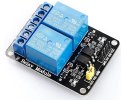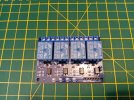collectors
Registered
Is there an advantage to 0v switching ? IE: if i had a long run of cable there may be a volt drop with 5v. Would this not be a problem with switching 0v.
The voltage drop is due to the resistance of the cable, and the current you are drawing..Is there an advantage to 0v switching ? IE: if i had a long run of cable there may be a volt drop with 5v. Would this not be a problem with switching 0v.
Sorry, What i should of said, if i have a 5v relay with the choice of 5v or 0v to energise the coil & lets say it was 500 meters cable length, the 5v might struggle, with 0v switching would this not be effected.The voltage drop is due to the resistance of the cable, and the current you are drawing..
V=IxR Ohm's law.
Hence we recommend larger cross-sectional cables for higher current. - Less resistance, so less voltage-drop, for a specific current.
You 'see' the same effect looking for a bad joint in your track..
A good meter will show 'full' track voltage, because a meter needs a very small current to register a voltage.
You only 'see' the voltage drop across the bad joint, when you are drawing a significant current.
Example :
5V supply, long run of cable 4 Ohms.
If your load at the end of the cable draws 1A,then Ohm's law gives a voltage drop at the load-end of;
1(amp) x 4(ohms) = 4Volts
If you are only drawing 100mA (0 1A) then the voltage drop is;
0.1(amp) x 4(ohms) = 0.4Volts
In the real-world, the resistance of your cable will be very small, and (for controls and lighting) possibly only a few Amps.
It is probably 'better' to run heavier cables, with a higher voltage, as an accessory power-bus.
Then use local regulators, to give you a local supply for the accessories.
PhilP
My apologises, its a Optocoupler Relay in that you can use 5v or 0v to trigger the coilNo, I'm still not getting through.
One side of the relay coil is got plus 5 volts, and the other side, ground (maybe you are calling 0 volts).
0 volts makes no sense unless it is referenced to something, for example a hamster is 0 volts.
Kidding aside, voltage has to be present, and current needs to flow.
how about showing a picture of the relay, or a part number or a circuit schematic?
perhaps this is a "solid state" relay?
Greg

GotchaIt doesn't make any difference which leg you switch. The voltage drop is caused by the current flowing in the circuit
Details in a posting on the Blog.Energised with 0 volts? Sorry I'm obviously missing something
I think the answer was given earlier, thanks


